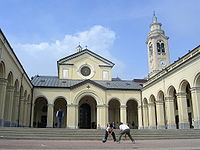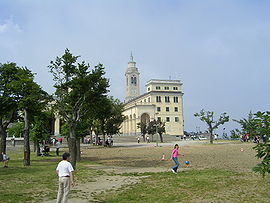
Shrine of Nostra Signora della Guardia
Encyclopedia

Pilgrimage
A pilgrimage is a journey or search of great moral or spiritual significance. Typically, it is a journey to a shrine or other location of importance to a person's beliefs and faith...
and is located on the top of Mount Figogna (804 m asl), in the Municipality of Ceranesi
Ceranesi
Ceranesi is a comune in the Province of Genoa in the Italian region Liguria, located about 11 km northwest of Genoa.The Municipality of Ceranesi includes also the Shrine of N.S. della Guardia, the most important Marian shrine in Liguria.Ceranesi borders the following municipalities: Bosio,...
, about 20 km from the city of Genoa
Genoa
Genoa |Ligurian]] Zena ; Latin and, archaically, English Genua) is a city and an important seaport in northern Italy, the capital of the Province of Genoa and of the region of Liguria....
, in the northwest of Italy
Italy
Italy , officially the Italian Republic languages]] under the European Charter for Regional or Minority Languages. In each of these, Italy's official name is as follows:;;;;;;;;), is a unitary parliamentary republic in South-Central Europe. To the north it borders France, Switzerland, Austria and...
.
It is the most important Marian shrine
Shrine
A shrine is a holy or sacred place, which is dedicated to a specific deity, ancestor, hero, martyr, saint, daemon or similar figure of awe and respect, at which they are venerated or worshipped. Shrines often contain idols, relics, or other such objects associated with the figure being venerated....
in Liguria
Liguria
Liguria is a coastal region of north-western Italy, the third smallest of the Italian regions. Its capital is Genoa. It is a popular region with tourists for its beautiful beaches, picturesque little towns, and good food.-Geography:...
.
The name “Guardia” in Italian means “watch” and the shrine is so called because the Mount Figogna, in the Middle Ages
Middle Ages
The Middle Ages is a periodization of European history from the 5th century to the 15th century. The Middle Ages follows the fall of the Western Roman Empire in 476 and precedes the Early Modern Era. It is the middle period of a three-period division of Western history: Classic, Medieval and Modern...
was a strategic observation post to control displacement of armies along Valpolcevera and ships in the sea in front of Genoa. From the esplanade in front of the shrine, in a clear day, you can view all the underlying Polcevera valley and part of the city of Genoa and the Ligurian Riviera
Italian Riviera
The Italian Riviera, or Ligurian Riviera is the narrow coastal strip which lies between the Ligurian Sea and the mountain chain formed by the Maritime Alps and the Apennines...
(and also, but only in a very clear day, mainly in winter, also the skyline of the mountains of the French island of Corse
Corse
Corse may refer to:*Corse, the French name for Corsica, the fourth largest island in the Mediterranean Sea*Corse , a European surname of multiple origins *Corse, a Shakespearean word for Corpse...
).
The Shrine
Shrine
A shrine is a holy or sacred place, which is dedicated to a specific deity, ancestor, hero, martyr, saint, daemon or similar figure of awe and respect, at which they are venerated or worshipped. Shrines often contain idols, relics, or other such objects associated with the figure being venerated....
is the destination of pilgrimages from Genoa and surroundings and all over Italy. The worship has been disseminated all over Italy and also abroad, so many churches and shrines have been consecrated to “Nostra Signora della Guardia”.
History

Nevertheless, Pareto went home and did not speak with anyone about the apparition. A few days later he fell from a tree and was seriously injured. The Virgin Mary appeared to him again and he was miraculously healed. The event convinced him to speak about the apparition and seek help to build the chapel.
The first chapel
According to tradition, the first chapel was built by Pareto himself at the site of the apparition. It is a small rectangular building with a wooden roof, now inside the new chapel. Within a nicheNiche (architecture)
A niche in classical architecture is an exedra or an apse that has been reduced in size, retaining the half-dome heading usual for an apse. Nero's Domus Aurea was the first semi-private dwelling that possessed rooms that were given richly varied floor plans, shaped with niches and exedras;...
is a marble
Marble
Marble is a metamorphic rock composed of recrystallized carbonate minerals, most commonly calcite or dolomite.Geologists use the term "marble" to refer to metamorphosed limestone; however stonemasons use the term more broadly to encompass unmetamorphosed limestone.Marble is commonly used for...
Madonna
Madonna (art)
Images of the Madonna and the Madonna and Child or Virgin and Child are pictorial or sculptured representations of Mary, Mother of Jesus, either alone, or more frequently, with the infant Jesus. These images are central icons of Roman Catholicism and Eastern Orthodox Christianity where Mary remains...
dated 1530.
The shrine


Pilgrim
A pilgrim is a traveler who is on a journey to a holy place. Typically, this is a physical journeying to some place of special significance to the adherent of a particular religious belief system...
s a shrine
Shrine
A shrine is a holy or sacred place, which is dedicated to a specific deity, ancestor, hero, martyr, saint, daemon or similar figure of awe and respect, at which they are venerated or worshipped. Shrines often contain idols, relics, or other such objects associated with the figure being venerated....
was built on the top of the mountain between 1528 and 1530, thanks to a donation of the noble family Ghersi. Near the shrine was also built a hospice for the pilgrims, which was rebuilt at the end of the 18th century.
In the second half of the 19th century a new shrine was built. There were both technical and financial setbacks, but the church was completed in 1889 and inaugurated on May 26 1890.
In the following years the number of pilgrims continued to increase, so in 1903 the old church was demolished to make room for a new hospice and guesthouse for the pilgrims.
On March 11, 1915 the Genoese Pope Benedict XV
Pope Benedict XV
Pope Benedict XV , born Giacomo Paolo Giovanni Battista della Chiesa, reigned as Pope from 3 September 1914 to 22 January 1922...
assigned to the church the title of Basilica
Basilica
The Latin word basilica , was originally used to describe a Roman public building, usually located in the forum of a Roman town. Public basilicas began to appear in Hellenistic cities in the 2nd century BC.The term was also applied to buildings used for religious purposes...
. Then, in 1917, the same pope built a small temple in the gardens of Vatican City
Vatican City
Vatican City , or Vatican City State, in Italian officially Stato della Città del Vaticano , which translates literally as State of the City of the Vatican, is a landlocked sovereign city-state whose territory consists of a walled enclave within the city of Rome, Italy. It has an area of...
where a statue of N.S. della Guardia (given to the Pope by Genoese people) was enshrined.
In 1929 a train (the “Autoguidovia”) was constructed, allowing pilgrims to reach the shrine from the bottom of the valley. Before this the only alternative was to go on foot. In 1963 a new road for vehicles was constructed (provincial road No 52 from Bolzaneto
Bolzaneto
Bolzaneto is a quarter of the city of Genoa, in northwest Italy, and is part of the Municipality Valpolcevera of Genoa.-Geography:Bolzaneto was once a hamlet located outside of the city limits in the Polcevera valley, but in the recent centuries it became an industrial area...
, 11 km long), and the “Autoguidovia”, considered uneconomic, was closed in 1967.
On September 22, 1985 the shrine was visited by Pope John Paul II
Pope John Paul II
Blessed Pope John Paul II , born Karol Józef Wojtyła , reigned as Pope of the Catholic Church and Sovereign of Vatican City from 16 October 1978 until his death on 2 April 2005, at of age. His was the second-longest documented pontificate, which lasted ; only Pope Pius IX ...
. On May 18, 2008 the shrine was visited by Pope Benedict XVI
Pope Benedict XVI
Benedict XVI is the 265th and current Pope, by virtue of his office of Bishop of Rome, the Sovereign of the Vatican City State and the leader of the Catholic Church as well as the other 22 sui iuris Eastern Catholic Churches in full communion with the Holy See...
.
Structure of the basilica
The new church was designed by Guglielmo Calmieri. It has a Latin cross shape with three aisleAisle
An aisle is, in general, a space for walking with rows of seats on both sides or with rows of seats on one side and a wall on the other...
s. The main aisle is painted with fresco
Fresco
Fresco is any of several related mural painting types, executed on plaster on walls or ceilings. The word fresco comes from the Greek word affresca which derives from the Latin word for "fresh". Frescoes first developed in the ancient world and continued to be popular through the Renaissance...
es (1963) by the Genoese painter Antonio Santagata (1888-1985) with scenes of the life of the Virgin Mary. The frescoes in the dome
Dome
A dome is a structural element of architecture that resembles the hollow upper half of a sphere. Dome structures made of various materials have a long architectural lineage extending into prehistory....
, painted by the Lombard painter Pasquale Arzuffi (1897-1965), represent Mary surrounded by the Republic of Genoa
Republic of Genoa
The Most Serene Republic of Genoa |Ligurian]]: Repúbrica de Zêna) was an independent state from 1005 to 1797 in Liguria on the northwestern Italian coast, as well as Corsica from 1347 to 1768, and numerous other territories throughout the Mediterranean....
patron saints.
In the church are also other statues representing the Virgin Mary and saints (St. John the Baptist
John the Baptist
John the Baptist was an itinerant preacher and a major religious figure mentioned in the Canonical gospels. He is described in the Gospel of Luke as a relative of Jesus, who led a movement of baptism at the Jordan River...
, St. Joseph, St. Eusebius
Eusebius of Vercelli
Eusebius of Vercelli was a bishop and saint in Italy. Along with Athanasius, he affirmed the divinity of Jesus against Arianism.-Biography:...
) and on the left of the high altar
Altar
An altar is any structure upon which offerings such as sacrifices are made for religious purposes. Altars are usually found at shrines, and they can be located in temples, churches and other places of worship...
, a black procession crucifix
Crucifix
A crucifix is an independent image of Jesus on the cross with a representation of Jesus' body, referred to in English as the corpus , as distinct from a cross with no body....
.
A door in the left aisle leads to the hall of offerings, where hundreds of paintings, photos and objects have been left by people to express their gratitude to the Virgin Mary for having been curing or protecting them from illnesses, accidents, wars and shipwrecks.

